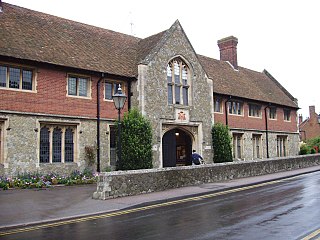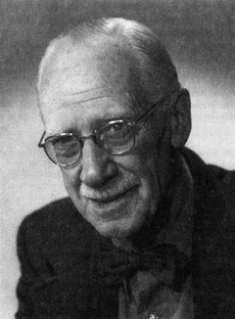Related Research Articles

King's College London is a public research university located in London, United Kingdom, and a founding college and member institution of the federal University of London. King's was established in 1829 by King George IV and Arthur Wellesley, 1st Duke of Wellington, when it received its first royal charter, and is one of the oldest universities in England. In 1836, King's became one of the two founding colleges of the University of London. In the late 20th century, King's grew through a series of mergers, including with Queen Elizabeth College and Chelsea College of Science and Technology, the Institute of Psychiatry, the United Medical and Dental Schools of Guy's and St Thomas' Hospitals and the Florence Nightingale School of Nursing and Midwifery.

Bert Sakmann is a German cell physiologist. He shared the Nobel Prize in Physiology or Medicine with Erwin Neher in 1991 for their work on "the function of single ion channels in cells," and invention of the patch clamp. Bert Sakmann was Professor at Heidelberg University and is an Emeritus Scientific Member of the Max Planck Institute for Medical Research in Heidelberg, Germany. Since 2008 he leads an emeritus research group at the Max Planck Institute of Neurobiology.

Erwin Neher is a German biophysicist, specializing in the field of cell physiology. For significant contribution in the field, in 1991 he was awarded, along with Bert Sakmann, the Nobel Prize in Physiology or Medicine for "their discoveries concerning the function of single ion channels in cells".

The College of St Gregory and St Martin at Wye, more commonly known as Wye College, was an educational institution in the small village of Wye, Kent, England, 60 miles (100 km) east of London in the North Downs area.
Sir Noel Robert Malcolm, is an English political journalist, historian and academic. A King's Scholar at Eton College, Malcolm read history at Peterhouse, Cambridge and received his Doctorate in History from Trinity College, Cambridge. He was a Fellow and College Lecturer of Gonville and Caius College, Cambridge, before becoming a political and foreign affairs journalist with The Spectator and the Daily Telegraph.

Anthony "Tony" James Pawson,, was a British-born Canadian scientist whose research has revolutionised the understanding of signal transduction, the molecular mechanisms by which cells respond to external cues, and how they communicate with each other. He identified the phosphotyrosine-binding Src homology 2 as the prototypic non-catalytic interaction module. SH2 domains serve as a model for a large family of protein modules that act together to control many aspects of cellular signalling. Since the discovery of SH2 domains, hundreds of different modules have been identified in many proteins.
The Randall Division of Cell and Molecular Biophysics is a research institute of King's College London located in London United Kingdom. It is a centre for study in allergy and asthma; muscle signalling and development; structural biology; muscle biophysics; cell motility and cytoskeleton, and cell imaging.
Robert or Rob Simmons may refer to:

Michael Cyril William Hunter is Emeritus Professor of History in the department of history, classics and archaeology and a Fellow of Birkbeck, University of London. Hunter is interested in the culture of early modern England. He specialises in the history of science in seventeenth- and early eighteenth-century England, particularly the work of Robert Boyle. In Noel Malcolm's judgement, Hunter "has done more for Boyle studies than anyone before him ".

Kenneth Stewart Cole was an American biophysicist described by his peers as "a pioneer in the application of physical science to biology". Cole was awarded the National Medal of Science in 1967.

Roger Yonchien Tsien was an American biochemist. He was a professor of chemistry and biochemistry at the University of California, San Diego and was awarded the 2008 Nobel Prize in Chemistry for his discovery and development of the green fluorescent protein, in collaboration with organic chemist Osamu Shimomura and neurobiologist Martin Chalfie. Tsien was also a pioneer of calcium imaging.

Sir Christopher Martin Dobson was a British chemist, who was the John Humphrey Plummer Professor of Chemical and Structural Biology in the Department of Chemistry at the University of Cambridge, and Master of St John's College, Cambridge.

Jonathan Felix Ashmore is a British physicist and Bernard Katz Professor of Biophysics at University College London.

Robert Fettiplace FRS is a British neuroscientist, and Steenbock Professor of Neural and Behavioral Sciences, at the University of Wisconsin–Madison.
David Christopher Gadsby FRS was a British physiologist, and Patrick A. Gerschel Family Professor Emeritus at The Rockefeller University. He was best known for his studies on the mechanisms by which ions move across cell membranes.
The British Biophysical Society is a scientific society that exists to encourage and disseminate developments in the application of physical and chemical concepts to biological systems. It was founded in 1960 following a report from a Working Party on Biophysics and Biophysical Chemistry initiated by the Council of the then Faraday Society of London.
Emmeline Jean Hanson, commonly known by her middle name Jean, was a biophysicist and zoologist known for her contributions to muscle research. Hanson gained her PhD in zoology from Bedford College, University of London before spending the majority of her career at a biophysics research unit at King's College London, where she was a founder member, and later its second Head. While working at Massachusetts Institute of Technology, she, with Hugh Huxley, discovered the mechanism of movement of muscle fibre in 1954, which came to known as "sliding filament theory". This was a groundbreaking research in muscle physiology, and for this BBC nicknamed her "Mrs Muscle" on the 50th anniversary of the discovery.
Nicholas Peter Franks FRS FRSB has been Professor of Biophysics and Anaesthetics at Imperial College London since 1993. His research focuses on how general anaesthetics act at the cell and molecular levels as well as with neuronal networks. Franks holds patents on use of xenon gas as a neuroprotectant and has published research on the use of the anesthetic properties of xenon.
John Tooze FRS research scientist, research administrator, author, science journalist, formerly Executive Director of EMBO/EMBC, Director of Research Services at the Cancer Research UK London Research Institute and a Vice President at The Rockefeller University.

Mark Andrew Lemmon an English-born biochemist, is a professor of Pharmacology at Yale University where he co-directs the Cancer Biology Institute with Joseph Schlessinger.
References
- ↑ "The cell: dissecting the new anatomy". King's College London . Retrieved 15 March 2016.
- ↑ ‘SIMMONS, Prof. Robert Malcolm’, Who's Who 2016, A & C Black, an imprint of Bloomsbury Publishing plc, 2016